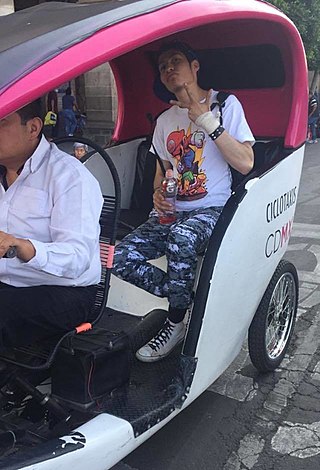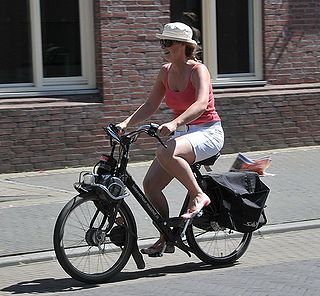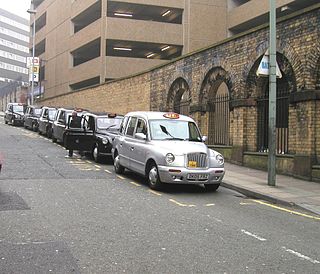
A truck or lorry is a motor vehicle designed to transport freight, carry specialized payloads, or perform other utilitarian work. Trucks vary greatly in size, power, and configuration, but the vast majority feature body-on-frame construction, with a cabin that is independent of the payload portion of the vehicle. Smaller varieties may be mechanically similar to some automobiles. Commercial trucks can be very large and powerful and may be configured to be mounted with specialized equipment, such as in the case of refuse trucks, fire trucks, concrete mixers, and suction excavators. In American English, a commercial vehicle without a trailer or other articulation is formally a "straight truck" while one designed specifically to pull a trailer is not a truck but a "tractor".

The cycle rickshaw is a small-scale local means of transport. It is a type of hatchback tricycle designed to carry passengers on a for-hire basis. It is also known by a variety of other names such as bike taxi, velotaxi, pedicab, bikecab, cyclo, beca, becak, trisikad, sikad, tricycle taxi, trishaw, or hatchback bike.

A hackney or hackney carriage is a carriage or car for hire. A hackney of a more expensive or high class was called a remise. A symbol of London and Britain, the black taxi is a common sight on the streets of London. The hackney carriages carry a roof sign TAXI that can be illuminated to indicate their availability for passengers.

Yellow cab taxicab operators exist all around the world. The original Yellow Cab Company, based in Chicago, Illinois, was one of the largest taxicab companies in the United States.

Hong Kong taxicabs provide taxi services in Hong Kong. Although a few taxis are independently owned and operated, the vast majority are owned by 17 independent taxi companies that rent out taxis on a shift basis to 40,000 self-employed drivers.

A motorized bicycle is a bicycle with an attached motor or engine and transmission used either to power the vehicle unassisted, or to assist with pedalling. Since it sometimes retains both pedals and a discrete connected drive for rider-powered propulsion, the motorized bicycle is in technical terms a true bicycle, albeit a power-assisted one. Typically they are incapable of speeds above 52 km/h (32 mph), however in recent years larger motors have been built, allowing bikes to reach speeds of upwards of 72 km/h.
Many countries have enacted electric vehicle laws to regulate the use of electric bicycles, also termed e-bikes. Some jurisdictions have regulations governing safety requirements and standards of manufacture. The members of the European Union and other regions have wider-ranging legislation covering use and safety.
Taxicabs within a country often share common properties, but there is a wide variation from country to country in the vehicles used, the circumstances under which they may be hired and the regulatory regime to which these are subject.
The taxicabs of the United States make up a mature system; most U.S. cities have a licensing scheme which restricts the number of taxicabs allowed. As of 2012 the total number of taxi cab drivers in the United States is 233,900; the average annual salary of a taxi cab driver is $22,820 and the expected percent job increase over the next 10 years is 16%.

Taxicabs are regulated throughout the United Kingdom, but the regulation of taxicabs in London is especially rigorous with regard to mechanical integrity and driver knowledge. An official report observed that: "Little however is known about the regulation by anyone outside the trade. The Public Carriage Office (PCO), which regulates and licenses taxis and private hire was transferred from the Metropolitan Police to become part of Transport for London in 2000." In 2015, there were around 298,000 licensed drivers in England, of which 164,000 were private hire licences, 62,000 were taxi licences and 72,000 were dual licences.

A herdic was a type of horse-drawn carriage, which was frequently used as an omnibus during the late nineteenth and early twentieth centuries. It was invented by Peter Herdic of Williamsport, Lycoming County, Pennsylvania during the 1870s and patented in 1880.
Illegal taxicabs, sometimes known as pirate taxis, gypsy cabs, or jitney cabs, are taxicabs and other for-hire vehicles that are not duly licensed or permitted by the jurisdiction in which they operate. Most major cities worldwide require taxicabs to be licensed, safety-inspected, insured as for-hire vehicles, and to use taximeters, and there may also be requirements that the taxi driver be registered or accredited. However, many unlicensed cabs are in operation. Illegal cabs may be marked taxi vehicles, and others are personal vehicles used by an individual to offer unauthorized taxi-like services. Illegal cabs are prevalent in cities with medallion systems, which restrict the number of legal cabs in operation. Since their introduction in 2009, vehicles affiliated with ridesharing companies have been classified as illegal taxicabs in some jurisdictions.
Los Angeles can refer to both the City of Los Angeles and Los Angeles County, as well as the larger Los Angeles region.

Cycling in New York City is associated with mixed cycling conditions that include dense urban proximities, relatively flat terrain, congested roadways with stop-and-go traffic, and streets with heavy pedestrian activity. The city's large cycling population includes utility cyclists, such as delivery and messenger services; cycling clubs for recreational cyclists; and increasingly commuters. Cycling is increasingly popular in New York City; in 2018 there were approximately 510,000 daily bike trips, compared with 170,000 daily bike trips in 2005.

A taxi, also known as a taxicab or simply a cab, is a type of vehicle for hire with a driver, used by a single passenger or small group of passengers, often for a non-shared ride. A taxicab conveys passengers between locations of their choice. This differs from public transport where the pick-up and drop-off locations are decided by the service provider, not by the customers, although demand responsive transport and share taxis provide a hybrid bus/taxi mode.

In the United States, vehicle safety inspection and emissions inspection are governed by each state individually. Fifteen states have a periodic safety inspection program, while Maryland requires a safety inspection and Alabama requires a VIN inspection on sale or transfer of vehicles which were previously registered in another state. An additional 16 states require periodic emissions inspections.

Rickshaw originally denoted a pulled rickshaw, which is a two- or three-wheeled cart generally pulled by one person carrying one passenger. The first known use of the term was in 1879. Over time, cycle rickshaws, auto rickshaws, and electric rickshaws were invented, and have replaced the original pulled rickshaws, with a few exceptions for their use in tourism.

A ridesharing company, ride-hailing service, is a company that, via websites and mobile apps, matches passengers with drivers of vehicles for hire that, unlike taxis, cannot legally be hailed from the street.

Ola Cabs is an Indian transportation company that provides ride-hailing services and operates other business verticals such as financial services and cloud kitchens. It is headquartered in Bangalore, and operates in 250+ Indian cities.
The legality of ridesharing companies by jurisdiction varies; in some areas they are considered to be illegal taxi operations, while in other areas, they are subject to regulations that can include requirements for driver background checks, fares, caps on the number of drivers in an area, insurance, licensing, and minimum wage.


















